+ Open data
Open data
- Basic information
Basic information
| Entry | Database: PDB / ID: 1hwu | ||||||
|---|---|---|---|---|---|---|---|
| Title | STRUCTURE OF PII PROTEIN FROM HERBASPIRILLUM SEROPEDICAE | ||||||
 Components Components | PII PROTEIN | ||||||
 Keywords Keywords | SIGNALING PROTEIN / Herbaspirillum seropedicae PII / Beta-alpha-beta motif / signal transduction protein | ||||||
| Function / homology |  Function and homology information Function and homology informationregulation of nitrogen utilization / enzyme regulator activity / ATP binding / cytosol Similarity search - Function | ||||||
| Biological species |  Herbaspirillum seropedicae (bacteria) Herbaspirillum seropedicae (bacteria) | ||||||
| Method |  X-RAY DIFFRACTION / X-RAY DIFFRACTION /  SYNCHROTRON / SYNCHROTRON /  MOLECULAR REPLACEMENT / Resolution: 2.1 Å MOLECULAR REPLACEMENT / Resolution: 2.1 Å | ||||||
 Authors Authors | Benelli, E.M. / Buck, M. / Polikarpov, I. / De Souza, E.M. / Cruz, L.M. / Pedrosa, F.O. | ||||||
 Citation Citation |  Journal: Eur.J.Biochem. / Year: 2002 Journal: Eur.J.Biochem. / Year: 2002Title: Herbaspirillum seropedicae signal transduction protein PII is structurally similar to the enteric GlnK. Authors: Machado Benelli, E. / Buck, M. / Polikarpov, I. / Maltempi de Souza, E. / Cruz, L.M. / Pedrosa, F.O. | ||||||
| History |
|
- Structure visualization
Structure visualization
| Structure viewer | Molecule:  Molmil Molmil Jmol/JSmol Jmol/JSmol |
|---|
- Downloads & links
Downloads & links
- Download
Download
| PDBx/mmCIF format |  1hwu.cif.gz 1hwu.cif.gz | 116.4 KB | Display |  PDBx/mmCIF format PDBx/mmCIF format |
|---|---|---|---|---|
| PDB format |  pdb1hwu.ent.gz pdb1hwu.ent.gz | 92.9 KB | Display |  PDB format PDB format |
| PDBx/mmJSON format |  1hwu.json.gz 1hwu.json.gz | Tree view |  PDBx/mmJSON format PDBx/mmJSON format | |
| Others |  Other downloads Other downloads |
-Validation report
| Summary document |  1hwu_validation.pdf.gz 1hwu_validation.pdf.gz | 457.7 KB | Display |  wwPDB validaton report wwPDB validaton report |
|---|---|---|---|---|
| Full document |  1hwu_full_validation.pdf.gz 1hwu_full_validation.pdf.gz | 469.8 KB | Display | |
| Data in XML |  1hwu_validation.xml.gz 1hwu_validation.xml.gz | 22.8 KB | Display | |
| Data in CIF |  1hwu_validation.cif.gz 1hwu_validation.cif.gz | 32.4 KB | Display | |
| Arichive directory |  https://data.pdbj.org/pub/pdb/validation_reports/hw/1hwu https://data.pdbj.org/pub/pdb/validation_reports/hw/1hwu ftp://data.pdbj.org/pub/pdb/validation_reports/hw/1hwu ftp://data.pdbj.org/pub/pdb/validation_reports/hw/1hwu | HTTPS FTP |
-Related structure data
| Related structure data | 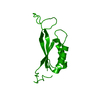 2piiS S: Starting model for refinement |
|---|---|
| Similar structure data |
- Links
Links
- Assembly
Assembly
| Deposited unit | 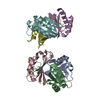
| ||||||||
|---|---|---|---|---|---|---|---|---|---|
| 1 | 
| ||||||||
| 2 | 
| ||||||||
| 3 | 
| ||||||||
| Unit cell |
|
- Components
Components
| #1: Protein | Mass: 12284.189 Da / Num. of mol.: 6 Source method: isolated from a genetically manipulated source Source: (gene. exp.)  Herbaspirillum seropedicae (bacteria) / Gene: GLNB / Plasmid: PET28B+ / Production host: Herbaspirillum seropedicae (bacteria) / Gene: GLNB / Plasmid: PET28B+ / Production host:  #2: Water | ChemComp-HOH / | |
|---|
-Experimental details
-Experiment
| Experiment | Method:  X-RAY DIFFRACTION / Number of used crystals: 1 X-RAY DIFFRACTION / Number of used crystals: 1 |
|---|
- Sample preparation
Sample preparation
| Crystal | Density Matthews: 2.21 Å3/Da / Density % sol: 44.33 % | |||||||||||||||||||||||||||||||||||||||||||||||||||||||||||||||
|---|---|---|---|---|---|---|---|---|---|---|---|---|---|---|---|---|---|---|---|---|---|---|---|---|---|---|---|---|---|---|---|---|---|---|---|---|---|---|---|---|---|---|---|---|---|---|---|---|---|---|---|---|---|---|---|---|---|---|---|---|---|---|---|---|
| Crystal grow | Temperature: 291 K / Method: vapor diffusion, hanging drop / pH: 6.5 Details: Sodium Cacodylate, Magnesium Acetate, Methylpentadiol, pH 6.5, VAPOR DIFFUSION, HANGING DROP, temperature 291K | |||||||||||||||||||||||||||||||||||||||||||||||||||||||||||||||
| Crystal grow | *PLUS pH: 8 / Method: vapor diffusion, hanging drop | |||||||||||||||||||||||||||||||||||||||||||||||||||||||||||||||
| Components of the solutions | *PLUS
|
-Data collection
| Diffraction | Mean temperature: 120 K |
|---|---|
| Diffraction source | Source:  SYNCHROTRON / Site: SYNCHROTRON / Site:  LNLS LNLS  / Beamline: D03B-MX1 / Wavelength: 1.38 Å / Beamline: D03B-MX1 / Wavelength: 1.38 Å |
| Detector | Type: MARRESEARCH / Detector: IMAGE PLATE / Date: Jun 18, 1998 |
| Radiation | Monochromator: Si 111 CHANNEL / Protocol: SINGLE WAVELENGTH / Monochromatic (M) / Laue (L): M / Scattering type: x-ray |
| Radiation wavelength | Wavelength: 1.38 Å / Relative weight: 1 |
| Reflection | Resolution: 2.1→13 Å / Num. all: 146413 / Num. obs: 36523 / % possible obs: 94.4 % / Observed criterion σ(I): 3 / Redundancy: 4 % / Rmerge(I) obs: 0.057 |
| Reflection shell | Resolution: 2.1→2.15 Å / Rmerge(I) obs: 0.322 / Num. unique all: 36523 / % possible all: 95.5 |
| Reflection | *PLUS % possible obs: 94 % / Redundancy: 3 % |
| Reflection shell | *PLUS Highest resolution: 2.1 Å / % possible obs: 95 % / Num. unique obs: 2415 |
- Processing
Processing
| Software |
| ||||||||||||||||||||
|---|---|---|---|---|---|---|---|---|---|---|---|---|---|---|---|---|---|---|---|---|---|
| Refinement | Method to determine structure:  MOLECULAR REPLACEMENT MOLECULAR REPLACEMENTStarting model: PDB ENTRY 2PII Resolution: 2.1→13 Å / Cross valid method: THROUGHOUT
| ||||||||||||||||||||
| Refinement step | Cycle: LAST / Resolution: 2.1→13 Å
| ||||||||||||||||||||
| Refine LS restraints |
| ||||||||||||||||||||
| Refinement | *PLUS Num. reflection obs: 36331 / Num. reflection Rfree: 1820 / % reflection Rfree: 5 % | ||||||||||||||||||||
| Solvent computation | *PLUS | ||||||||||||||||||||
| Displacement parameters | *PLUS |
 Movie
Movie Controller
Controller




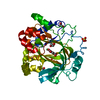

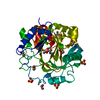
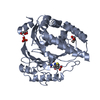

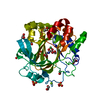
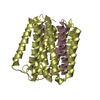
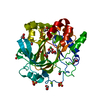

 PDBj
PDBj
